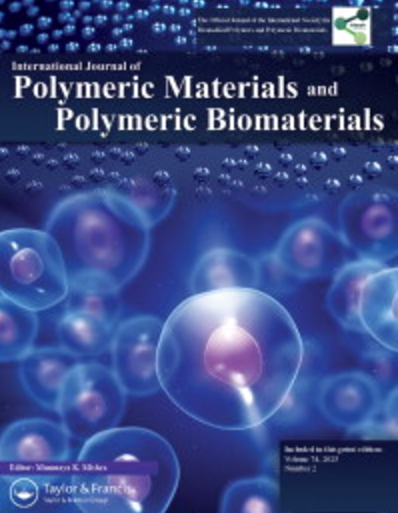静电纺丝和3D打印制备的组织工程用聚己内酯、聚乳酸和纳米羟基磷灰石支架
IF 2.6
4区 医学
Q4 MATERIALS SCIENCE, BIOMATERIALS
International Journal of Polymeric Materials and Polymeric Biomaterials
Pub Date : 2023-11-07
DOI:10.1080/00914037.2023.2277222
引用次数: 0
摘要
摘要骨组织自然移植物缺乏人工合成替代物。3D打印和静电纺丝生成的支架具有足够的机械性能,可以保持适合细胞生长的结构。在这里,制造了一个由三维(3D)打印的PLA框架和PCL/PLA/nHA纳米纤维组成的支架。该框架显示出与其他已报道的骨替代品相似的机械性能,而纳米纤维的直径在200到850纳米之间。当与成纤维细胞进行评估时,支架适合细胞粘附和增殖,显示细胞增殖成纳米纤维网络,这是组织工程的一个基本方面。关键词:纳米纤维聚聚合物支架,选择电旋聚乳酸,聚己内酯,羟基磷灰石,组织工程,骨致谢gonzalez Rodríguez Omar A.和Ramírez Guerrero Nancy承认美国国家骨科学研究所博士奖学金,N°001406。披露声明作者声明,他们没有已知的竞争经济利益或个人关系,可能会影响本文所报道的工作。作者贡献statementGonzález Rodríguez Omar Alejandro:概念化,方法论,Ramírez Guerrero Nancy Cecilia:方法论,软件,Casañas Pimentel Rocio Guadalupe:可视化,调查,Jaime Fonseca Mónica Rosalia:写作-审查和编辑,San Martín Martínez Eduardo:概念化,数据管理,写作-原始草稿准备。数据可用性声明数据可应要求提供。本研究得到了墨西哥国家人道主义委员会、墨西哥科学协会Tecnologías (CONAHCYT)、墨西哥政治学院Secretaría de Investigación y Posgrado的支持。本文章由计算机程序翻译,如有差异,请以英文原文为准。
Polycaprolactone, polylactic acid, and nanohydroxyapatite scaffolds obtained by electrospinning and 3D printing for tissue engineering
AbstractThere is a deficit for bone tissue natural grafts that seek to be covered with synthetic substitutes. Scaffolds generated with 3D printing and electrospinning allow adequate mechanical properties maintaining a structure appropriate for cell growth. Here, a scaffold made up of three-dimensional (3D) printed PLA frameworks added with PCL/PLA/nHA nanofibers was manufactured. The framework showed mechanical properties similar to other reported bone substitutes, while the nanofibers showed diameters between 200 and 850 nm. Scaffolds were suitable for cell adhesion and proliferation when evaluated with fibroblasts, showing cell proliferation into the nanofiber network, a fundamental aspect in tissue engineering.Keywords: Nanofiberspolymeric scaffoldselectrospunpolylactic acidpolycaprolactonenanohydroxyapatitetissue engineeringbone AcknowledgmentsGonzalez Rodríguez Omar A. and Ramírez Guerrero Nancy acknowledge doctoral fellowship from CONACyT, N° 001406.Disclosure statementThe authors declare that they have no known competing financial interests or personal relationships that could have appeared to influence the work reported in this article.CRediT authorship contribution statementGonzález Rodríguez Omar Alejandro: Conceptualization, Methodology, Ramírez Guerrero Nancy Cecilia: Methodology, Software, Casañas Pimentel Rocio Guadalupe: Visualization, Investigation, Jaime Fonseca Mónica Rosalia: Writing – Reviewing and Editing, San Martín Martínez Eduardo: Conceptualization, Data curation, Writing – Original draft preparation.Data availability statementData will be made available on request.Additional informationFundingThis work was supported by Consejo Nacional de Humanidades, Ciencias y Tecnologías (CONAHCYT), Mexico, Secretaría de Investigación y Posgrado, Instituto Politécnico Nacional.
求助全文
通过发布文献求助,成功后即可免费获取论文全文。
去求助
来源期刊

International Journal of Polymeric Materials and Polymeric Biomaterials
Chemical Engineering-General Chemical Engineering
CiteScore
8.00
自引率
3.10%
发文量
97
审稿时长
3.3 months
期刊介绍:
International Journal of Polymeric Materials and Polymeric Biomaterials is the official publication of the International Society for Biomedical Polymers and Polymeric Biomaterials (ISBPPB). This journal provides a forum for the publication of peer-reviewed, English language articles and select reviews on all aspects of polymeric materials and biomedical polymers. Being interdisciplinary in nature, this journal publishes extensive contributions in the areas of encapsulation and controlled release technologies to address innovation needs as well.
 求助内容:
求助内容: 应助结果提醒方式:
应助结果提醒方式:


